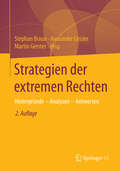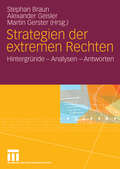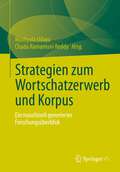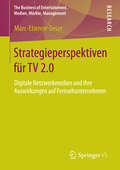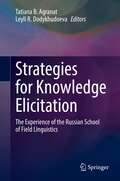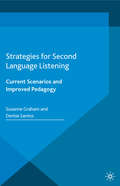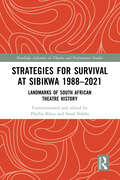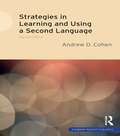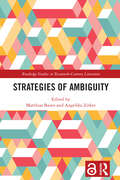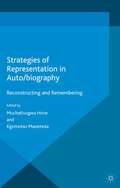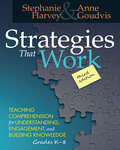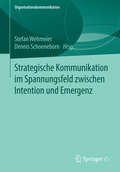- Table View
- List View
Strategien der extremen Rechten: Hintergründe - Analysen - Antworten
by Stephan Braun Alexander Geisler Martin GersterDieser Band behandelt nicht nur deskriptiv das Phänomen des Rechtsextremismus, sondern analysiert die konkreten Strategien von Akteuren und Organisationen des gesamten rechten Spektrums – ihre Grundlagen, Bedingungen und Ausprägungen auf allen Ebenen der Gesellschaft. Dabei werden bewusst unterschiedliche Perspektiven der akademischen und praktischen Auseinandersetzung mit dieser heterogenen Strömung aufgegriffen und Gegenstrategien angesprochen, die sich im Umgang mit den unterschiedlichen Teilen der extremen Rechten bewährt haben. Die aktualisierte und erweiterte Neuauflage bezieht dabei verschiedene, zum Teil sogar kontroverse Standpunkte aus Wissenschaft, Publizistik, der politischen Praxis und der Zivilgesellschaft ein. Gerade in der Vielfalt der Zugänge kristallisiert sich ein Gesamtbild heraus, das den Kern des strategischen Wirkens der extremen Rechten deutlich hervortreten lässt.
Strategien der extremen Rechten: Hintergründe - Analysen - Antworten
by Stephan Braun Alexander Geisler Martin GersterDieser Band schließt eine Lücke: Er behandelt nicht nur deskriptiv das Phänomen des Rechtsextremismus, sondern analysiert die konkreten Strategien rechtsextremistischer Akteure und Organisationen, ihre Grundlagen, Bedingungen und Ausprägungen auf allen Ebenen der Gesellschaft. Dabei werden bewusst die vielfältigen Perspektiven der akademischen und praktischen Auseinandersetzung mit dieser heterogenen Strömung aufgegriffen und Gegenstrategien angesprochen, die sich im Umgang mit den unterschiedlichen Teilen dieses Spektrums bewährt haben. Der Band bezieht dabei verschiedene, zum Teil sogar kontroverse Standpunkte aus Wissenschaft, Publizistik, der politischen Praxis und der Zivilgesellschaft ein.
Strategien der Verständigungssicherung: Zur Lösung einer universellen Aufgabe von Kommunikation (Language & Cognition)
by Walther Kindt Yvonne RittgerothStrategien erfolgreicher TV-Marken: Eine internationale Analyse
by Kati FörsterWarum schalten wir das ZDF und nicht ProSieben ein? Warum baut die ABC in den USA ihre Kommunikation rund um Serien wie Desperate Housewives auf, während die BBC in Großbritannien den Sender als Marke in den Mittelpunkt stellt? Wie gelingt es spanischen Sendern, das Internet und Social Media Plattformen so gut zu integrieren? Diesen und anderen Fragen geht das vorliegende Buch nach, indem zwölf Fernsehsender aus den USA, Großbritannien, Spanien und Deutschland untersucht werden. Ausgehend von einer strategischen Markenanalyse mit ihren Werten, ihrer Persönlichkeit, wird der Blick auf die Umsetzung dieser Markenversprechen in der Programm- und Kommunikationspolitik gelegt.
Strategien zum Wortschatzerwerb und Korpus: Ein maschinell generierter Forschungsüberblick
by Muthyala Udaya Chada Ramamuni ReddyDieses Buch untersucht den Bereich der ESL/EFL-Wortschatz- und Korpusstudien aus fünf umfassenden Perspektiven: Erwerb, Strategien, IKT, Korpus und aktuelle Praktiken. Die fünf Abschnitte des Buches sind so gruppiert, dass eine ausgewogene Abdeckung der Beschreibungen, wie Vokabeln erworben werden, und der verschiedenen Strategien, die von Lernenden und Lehrenden eingesetzt werden, um den Wortschatz zu beherrschen, erreicht wird. Einer der Abschnitte befasst sich mit dem Einfluss der Informations- und Kommunikationstechnologien auf das Lernen und neue Lehrmethoden. Der Abschnitt über das Lehren und Lernen von Korpus und Wortschatz enthält Zusammenfassungen darüber, wie Korpora die Sprache der Lernenden sein können und wie sie sich direkt auf den Unterricht auswirken. Der letzte Abschnitt über aktuelle Praktiken und Forschung beleuchtet die von Lehrenden und Forschenden angewandten Praktiken bei der Entwicklung des Themas Wortschatz. Dieses Buch ist eine wertvolle Ressource für Forschende, Lehrende und Sprachmittler*innen, die sich für die Natur des Wortschatzes im ESL/EFL-Lehr- und Lernkontext interessieren.
Strategieperspektiven für TV 2.0: Digitale Netzwerkmedien und ihre Auswirkungen auf Fernsehunternehmen (The Business of Entertainment. Medien, Märkte, Management)
by Marc-Etienne GeserAusgehend von der Auflösung der strikt linearen Bewegtbildkommunikation untersucht Marc-Etienne Geser die strategischen Optionen privater Fernsehunternehmen zur (Weiter-)Entwicklung ihrer Medienangebote und Geschäftsmodelle in digitalen Netzwerkmedien. Der Autor zeichnet ein fundiertes Bild der neuen strategischen Herausforderungen für private Fernsehunternehmen vor dem Hintergrund von Digitalisierung und Konvergenz der Telekommunikations-, Informations-, Medien- und Unterhaltungsmärkte. Er bietet – abgeleitet aus der unternehmensstrategischen Theorie – lösungsorientierte Handlungsschritte für die strategisch notwendige Transformation zu einem Netzwerkmedienunternehmen, mit der private Fernsehunternehmen den Weg von einer „Push-Ökonomie“ zu einer „Pull-Ökonomie“ gestalten können.
Strategies for Growing and Enhancing University-Level Japanese Programs
by Fumie KatoStrategies for Growing and Enhancing University-Level Japanese Programs offers foreign language program managers and directors, as well as teachers of less commonly taught languages, the insights and proven practical actions they can take to enhance and grow their language programs. Using the Japanese program at UNC Charlotte as the primary case study, author Fumie Kato provides step-by-step instructions on how she grew the Japanese program there from 133 students per semester in 2002 to 515 students per semester in 2017; from a program with just one full-time professor and one part-time faculty member, to a faculty of seven full-time and three part-time members. While Japanese is the example used in the book, the principles can be applied by anyone managing foreign language/less commonly taught language programs who wishes to expand their program and raise their students’ success rates. The book is therefore of interest to instructors, coordinators and directors of foreign language education programs throughout the world.
Strategies for Growing and Enhancing University-Level Japanese Programs
by Fumie KatoStrategies for Growing and Enhancing University-Level Japanese Programs offers foreign language program managers and directors, as well as teachers of less commonly taught languages, the insights and proven practical actions they can take to enhance and grow their language programs. Using the Japanese program at UNC Charlotte as the primary case study, author Fumie Kato provides step-by-step instructions on how she grew the Japanese program there from 133 students per semester in 2002 to 515 students per semester in 2017; from a program with just one full-time professor and one part-time faculty member, to a faculty of seven full-time and three part-time members. While Japanese is the example used in the book, the principles can be applied by anyone managing foreign language/less commonly taught language programs who wishes to expand their program and raise their students’ success rates. The book is therefore of interest to instructors, coordinators and directors of foreign language education programs throughout the world.
Strategies for Knowledge Elicitation: The Experience of the Russian School of Field Linguistics
by Tatiana B. Agranat Leyli R. DodykhudoevaThis volume provides an overview of experimental methods, approaches, and techniques used by field linguists of the Russian school, and highlights the fieldwork experience of Russian scholars working in regions with a range of languages that differ genetically, typologically, and in the degree of their preservation.The collection presents language and sociolinguistic data relating to fieldwork in diverse languages: Uralic, Altaic, Paleo-Siberian, Yeniseian, Indo-European Iranian, Vietic, Kra-Day, and Mayan languages, as well as pidgin.The authors highlight the fieldwork techniques they use, and the principles underlying them.The volume’s multidisciplinary approach covers linguistic, ethnolinguistic, sociolinguistic, educational, and ethnocultural issues. The authors explore problems associated with the study of minority languages and indicate diverse and creative techniques for data elicitation. Close collaboration with speakers lies at the core of their approach. The collection presents strategies for eliciting systems of knowledge from mother-tongue speakers, triggering linguistic self-awareness, and providing semantic and morphosyntactic context for their languages.This publication is intended for academics, and for specialists in the field of linguistics and minority and indigenous languages. It will also benefit students as a guide to field research, as well as language activists, interested in documenting and preserving their mother tongue.
Strategies for Second Language Listening: Current Scenarios and Improved Pedagogy
by Suzanne Graham Denise SantosThis book seeks to help teachers teach listening in a more principled way by presenting what is known from research, exploring teachers' beliefs and practices, examining textbook materials, and offering practical activities for improving second language listening.
Strategies for Survival at SIBIKWA 1988 – 2021: Landmarks of South African Theatre History (Routledge Advances in Theatre & Performance Studies)
by Phyllis Klotz Smal NdabaThis book provides an engaging and contextualised insight into a South African township-based arts centre that has survived the vicissitudes of steady militarisation in townships during some of the worst years of apartheid as well as the exhilaration of a new democratic policy while attempting to circumnavigate different policies and funding dispensations. Sibikwa provides arts centres across the world and especially those in decolonising countries with strategies for survival in tumultuous times. This multi-disciplinary book maps and co-ordinates wider historical, political, and social contextual concerns and events with matters specific to a community-based east of Johannesburg and provides an exploration and analysis by experts of authentic theatre-making and performance, dance, indigenous music, arts in education and NGO governance. It has contemporary significance and raises important questions regarding inclusivity and transformation, the function and future of arts centres, community-based applied arts practices, creativity, and international partnerships. This study will be of great interest to students and scholars in theatre and performance, indigenous music, dance, and South African history.
Strategies for Survival at SIBIKWA 1988 – 2021: Landmarks of South African Theatre History (Routledge Advances in Theatre & Performance Studies)
by Phyllis Klotz Smal NdabaThis book provides an engaging and contextualised insight into a South African township-based arts centre that has survived the vicissitudes of steady militarisation in townships during some of the worst years of apartheid as well as the exhilaration of a new democratic policy while attempting to circumnavigate different policies and funding dispensations. Sibikwa provides arts centres across the world and especially those in decolonising countries with strategies for survival in tumultuous times. This multi-disciplinary book maps and co-ordinates wider historical, political, and social contextual concerns and events with matters specific to a community-based east of Johannesburg and provides an exploration and analysis by experts of authentic theatre-making and performance, dance, indigenous music, arts in education and NGO governance. It has contemporary significance and raises important questions regarding inclusivity and transformation, the function and future of arts centres, community-based applied arts practices, creativity, and international partnerships. This study will be of great interest to students and scholars in theatre and performance, indigenous music, dance, and South African history.
Strategies in Learning and Using a Second Language
by Andrew D. CohenStrategies in Learning and Using a Second Language examines what it takes to achieve long-term success in languages beyond the first language. Distinguishing language learning from language-use strategies, Andrew D. Cohen disentangles a morass of terminology to help the reader see what language strategies are and how they can enhance performance. Particular areas of research examined in the book include: - links between the use of task-specific strategies and language performance - how multilinguals verbalise their thoughts during language learning and use strategies that learners use in test-taking contexts In this fully revised and substantially rewritten second edition, every chapter has been reworked, with material either updated or replaced. Entirely new material has also been developed based on examples of specific strategies supplied by actual learners, mostly drawn from a website featuring these strategies in the learning of Spanish grammar.Strategies in Learning and Using a Second language will be an invaluable resource for language teachers and researchers, as well as for administrators of second language programmes and for students of applied linguistics.
Strategies in Learning and Using a Second Language
by Andrew D. CohenStrategies in Learning and Using a Second Language examines what it takes to achieve long-term success in languages beyond the first language. Distinguishing language learning from language-use strategies, Andrew D. Cohen disentangles a morass of terminology to help the reader see what language strategies are and how they can enhance performance. Particular areas of research examined in the book include: - links between the use of task-specific strategies and language performance - how multilinguals verbalise their thoughts during language learning and use strategies that learners use in test-taking contexts In this fully revised and substantially rewritten second edition, every chapter has been reworked, with material either updated or replaced. Entirely new material has also been developed based on examples of specific strategies supplied by actual learners, mostly drawn from a website featuring these strategies in the learning of Spanish grammar.Strategies in Learning and Using a Second language will be an invaluable resource for language teachers and researchers, as well as for administrators of second language programmes and for students of applied linguistics.
Strategies of Ambiguity (Routledge Studies in Twentieth-Century Literature)
by Matthias Bauer Angelika ZirkerThere has been a growing awareness that ambiguity is not just a necessary evil of the language system resulting, for instance, from its need for economy or, by contrast, a blessing that allows writers to involve readers in endless games of assigning meaning to a literary text. The present volume contributes to overcoming this alternative by focusing on strategies of ambiguity (and the strategic avoidance of ambiguity) both at the production and the reception end of communication. The authors examine ways in which speakers and hearers may use ambiguous words, structures, references, and situations to pursue communicative ends. For example, the question is asked what it actually means when a listener strategically perceives ambiguity, which may happen both synchronically (e.g. in conversations) as well as diachronically (e.g. when strategically ambiguating biblical texts in order to make them applicable to moral lessons). Another example is the question of whether ambiguity awareness increases the strategic use of ambiguity in prosody. Moreover, the authors enquire not only into the effects of ambiguous meanings but also into the strategic use of ambiguity as such, for example, as a response to censorship or as a means of provoking irritation. This volume brings together several contributions from linguistics, literary studies, rhetoric, psychology, and theology, and it aims to provide a systematic approach to the strategic production and perception of ambiguity in a variety of texts and contexts.The Open Access version of this book, available at http://www.taylorfrancis.com, has been made available under a Creative Commons Attribution-Non Commercial-No Derivatives 4.0 license.
Strategies of Ambiguity (Routledge Studies in Twentieth-Century Literature)
by Matthias Bauer Angelika ZirkerThere has been a growing awareness that ambiguity is not just a necessary evil of the language system resulting, for instance, from its need for economy or, by contrast, a blessing that allows writers to involve readers in endless games of assigning meaning to a literary text. The present volume contributes to overcoming this alternative by focusing on strategies of ambiguity (and the strategic avoidance of ambiguity) both at the production and the reception end of communication. The authors examine ways in which speakers and hearers may use ambiguous words, structures, references, and situations to pursue communicative ends. For example, the question is asked what it actually means when a listener strategically perceives ambiguity, which may happen both synchronically (e.g. in conversations) as well as diachronically (e.g. when strategically ambiguating biblical texts in order to make them applicable to moral lessons). Another example is the question of whether ambiguity awareness increases the strategic use of ambiguity in prosody. Moreover, the authors enquire not only into the effects of ambiguous meanings but also into the strategic use of ambiguity as such, for example, as a response to censorship or as a means of provoking irritation. This volume brings together several contributions from linguistics, literary studies, rhetoric, psychology, and theology, and it aims to provide a systematic approach to the strategic production and perception of ambiguity in a variety of texts and contexts.The Open Access version of this book, available at http://www.taylorfrancis.com, has been made available under a Creative Commons Attribution-Non Commercial-No Derivatives 4.0 license.
Strategies of Representation in Auto/biography: Reconstructing and Remembering
by Muchativugwa Hove Kgomotso MasemolaStrategies of Representation in Auto/biography investigates how selves are represented and reconstructed in selected auto/biographical readings from African literary discourse. It examines how such representations confirm, validate, interrogate and pervade conversations with issues of identity, nation and history. In addition to providing an overview of the multidimensionality of auto/biography, the book also introduces readers to various ways of reading and analysing auto/biographical writings and develops specific perspectives on the genre and views inherently expressed through the re-imagined, re-membered and re-constructed self that speaks through the pages of autobiographical scripting. The focus on auto/biographical writings from southern Africa, specifically South Africa and Zimbabwe, offers a fresh reading of the work of significant figures in the political, economic and sociological spheres of these nation states. This collection shows that auto/biography may be more than simply the representation of an individual life, and that the socio-cultural memory of a people is a core aspect influencing individual self-representation.
Strategies of Silence: Reflections on the Practice and Pedagogy of Creative Writing (Routledge Studies in Creative Writing)
by Simon Heywood Moy McCroryThis unique book takes silence as its central concept and questions the range of meanings and values which inform the idea as it impinges on the creative process and its content and contexts. The thematic core of silence allows a consideration of silencing and silence as opposite ends of a spectrum: one shutting down, the other enabling and opening up. As a multidisciplinary collection of essays derived from the teaching and implementation of Creative Writing at university level, the contributors consider silence as strategic, both through the need for silence and as something which compels resistance. They explore how writing has employed images and tropes of silence in the past, and used silence and gaps technically. In considering marginalised and forgotten voices, this book shows how writers bring their diverse range of backgrounds and experience to work with and against silence in Creative Writing Studies. The first theoretical work on silence in Creative Writing, this field-shifting book is an essential read for both practitioners and students of Creative Writing at the higher education level.
Strategies of Silence: Reflections on the Practice and Pedagogy of Creative Writing (Routledge Studies in Creative Writing)
by Moy McCrory Simon HeywoodThis unique book takes silence as its central concept and questions the range of meanings and values which inform the idea as it impinges on the creative process and its content and contexts. The thematic core of silence allows a consideration of silencing and silence as opposite ends of a spectrum: one shutting down, the other enabling and opening up. As a multidisciplinary collection of essays derived from the teaching and implementation of Creative Writing at university level, the contributors consider silence as strategic, both through the need for silence and as something which compels resistance. They explore how writing has employed images and tropes of silence in the past, and used silence and gaps technically. In considering marginalised and forgotten voices, this book shows how writers bring their diverse range of backgrounds and experience to work with and against silence in Creative Writing Studies. The first theoretical work on silence in Creative Writing, this field-shifting book is an essential read for both practitioners and students of Creative Writing at the higher education level.
Strategies That Work: Teaching Comprehension for Engagement, Understanding, and Building Knowledge, Grades K-8
by Stephanie Harvey Anne GoudvisSince the first publication of Strategies That Work , numerous new books on reading comprehension have been published and more educators than ever are teaching comprehension. In this third edition of their groundbreaking book, authors Stephanie Harvey and Anne Goudvis bring you Strategies That Work: Teaching Comprehension for Understanding, Engagement, and Building Knowledge. This new edition is organized around three section: Part I: Starting with the Foundation of Meaning, these chapters provide readers with a solid introduction to reading comprehension instruction, including principles that guide practice, suggestions for text selection, and a review of recent research Part II: Part II contains lessons to put these principles into practices for all areas of reading comprehension Part III: This section shows you how to integrate comprehension instruction across the curriculum and the school day, with a focus on science and social studies. In addition, this new version includes updated bibliographies, including the popular Great Books for Teaching Content, online resources, and fully revised chapters focusing on digital reading, strategies for integrating comprehension and technology, and comprehension across the curriculum. Harvey and Goudvis tackle close reading, close listening, text complexity, and critical thinking and demonstrate how your students can build knowledge through thinking-intensive reading and learning. This third edition is a must-have resource for a generation of new teachers – and a welcome refresher for those with dog-eared copies of this timeless guide to reading comprehension.
Strategies That Work: Teaching Comprehension for Engagement, Understanding, and Building Knowledge, Grades K-8
by Stephanie Harvey Anne GoudvisSince the first publication of Strategies That Work , numerous new books on reading comprehension have been published and more educators than ever are teaching comprehension. In this third edition of their groundbreaking book, authors Stephanie Harvey and Anne Goudvis bring you Strategies That Work: Teaching Comprehension for Understanding, Engagement, and Building Knowledge. This new edition is organized around three section: Part I: Starting with the Foundation of Meaning, these chapters provide readers with a solid introduction to reading comprehension instruction, including principles that guide practice, suggestions for text selection, and a review of recent research Part II: Part II contains lessons to put these principles into practices for all areas of reading comprehension Part III: This section shows you how to integrate comprehension instruction across the curriculum and the school day, with a focus on science and social studies. In addition, this new version includes updated bibliographies, including the popular Great Books for Teaching Content, online resources, and fully revised chapters focusing on digital reading, strategies for integrating comprehension and technology, and comprehension across the curriculum. Harvey and Goudvis tackle close reading, close listening, text complexity, and critical thinking and demonstrate how your students can build knowledge through thinking-intensive reading and learning. This third edition is a must-have resource for a generation of new teachers – and a welcome refresher for those with dog-eared copies of this timeless guide to reading comprehension.
Strategische Kommunikation: Umrisse und Perspektiven eines Forschungsfeldes
by Ulrike Röttger, Volker Gehrau and Joachim PreusseIn der Forschung zur strategischen Kommunikation dominieren Ansätze, die sich auf den Organisationstypus „Unternehmen“ beziehen. Zudem zeigt sich – auch bei kommunikationswissenschaftlich geprägten Ansätzen – eine starke Orientierung an betriebswirtschaftlichen Fragestellungen und Problemdeutungen. Mit der betriebswirtschaftlichen Orientierung geht in der Regel ein ausgeprägt instrumentelles Verständnis strategischer Kommunikation einher, das ihren sozialen bzw. gesellschaftlichen Kontext fast vollständig ausblendet. Die BeitragsautorInnen nehmen eine erweiterte Forschungsperspektive auf das Phänomen strategischer Kommunikation ein. Strategische Kommunikation hat als (Impuls für) öffentliche Kommunikation gesellschaftliche Relevanz und tangiert regelmäßig – intentional oder transintentional – Interessen und Handlungsmöglichkeiten unterschiedlicher gesellschaftlicher Gruppen. Strategische Kommunikation wird nicht nur als Organisationsfunktion (und damit als organisationale Auftragskommunikation) betrachtet, sondern es wird auch die gesellschaftliche Eingebundenheit und Folgenhaftigkeit strategischer Kommunikation in den Blick genommen. Es werden Phänomene und Aspekte strategischer Kommunikation in unterschiedlichen gesellschaftlichen Handlungsfeldern und im Zusammenhang mit unterschiedlichen Organisationstypen thematisiert und analysiert.
Strategische Kommunikation deutscher Großkirchen: Von kirchlicher Publizistik zur strategischen Kirchenkommunikation (Organisationskommunikation)
by Markus WiesenbergMarkus Wiesenberg liefert eine begriffliche und konzeptionelle interdisziplinäre Grundlegung einer Kirchenkommunikation sowie umfassende empirische Einblicke in die Praxis der strategischen Kommunikation organisierter Religion. Vor dem Hintergrund der schwindenden Legitimation der deutschen Großkirchen (römisch-katholisch und evangelisch) verknüpft er theoretisch-konzeptionell kommunikationswissenschaftliche und religionssoziologische Perspektiven zu einer Theorie strategischer Kirchenkommunikation. In einer komparativen Fallstudie analysiert der Autor mittels einer Mehrebenenuntersuchung in 15 deutschen Großstädten sowohl die Ebene der Gemeinden und Pfarreien als auch der Landeskirchen, Bistümer sowie der EKD und der Bischofskonferenz.
Strategische Kommunikation im Spannungsfeld zwischen Intention und Emergenz (Organisationskommunikation)
by Stefan Wehmeier Dennis SchoenebornStrategische Kommunikation ist ein wachsendes Feld innerhalb der Kommunikationsforschung. Strategische Kommunikation bewegt sich in der Praxis jedoch zumeist in einem Spannungsfeld zwischen intendierten, zielgerichteten Kommunikationspraktiken einerseits und nicht-intendierten, emergenten Kommunikationspraktiken andererseits, die nichtsdestotrotz strategische Wirkung entfalten können. Der Band dokumentiert Ergebnisse und Debatten zum Spannungsfeld der strategischen Kommunikation, basierend auf der Jahrestagung 2015 der DGPuK-Fachgruppe PR und Organisationskommunikation an der Universität Greifswald.
Strategische Onlinekommunikation: Theoretische Konzepte und empirische Befunde
by Olaf Hoffjann Thomas PleilOnlinekommunikation und speziel Social Media sind als besonders wichtige Herausforderungen des Kommunikationsmanagements erkannt. Kaum ein Unternehmen verzichtet mittlerweile auf die Beobachtung von Diskussionen im Internet und die Umsetzung eigener Kommunikationsstrategien im Social Web. Dort verändern sich für die PR und die Organisationskommunikation zentrale Aspekte: Öffentlichkeiten können heute sehr viel schneller entstehen. Es sind neue Formen der Meinungsbildung zu beobachten, die zunehmend weniger den Mechanismen der Massenkommunikation folgen, sondern Ergebnis netzwerkartiger Prozesse sind. In diesem Umfeld entstehen gleichzeitig neue Formen der Beteiligung, die durch entsprechende niederschwellige Instrumente im Internet erst ermöglicht werden. Aus Organisationssicht verändern sich damit unter anderem Entstehung und Pflege von Reputation oder das Management von Stakeholderbeziehungen. Zehn Jahre nach Beginn der Fachdiskussion zu PR und sozialen Medien gibt dieser Band auf Basis aktueller Untersuchungen Einblick in die Praxis und in aktuelle Herausforderungen der Organisationskommunikation im Internet.
